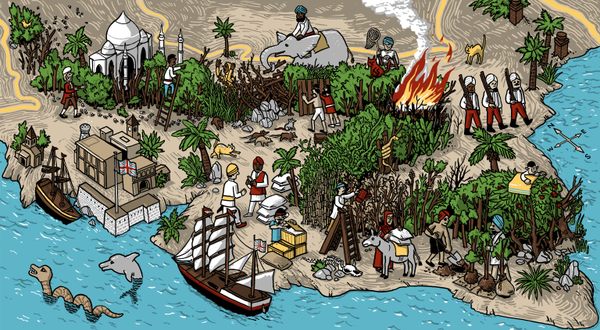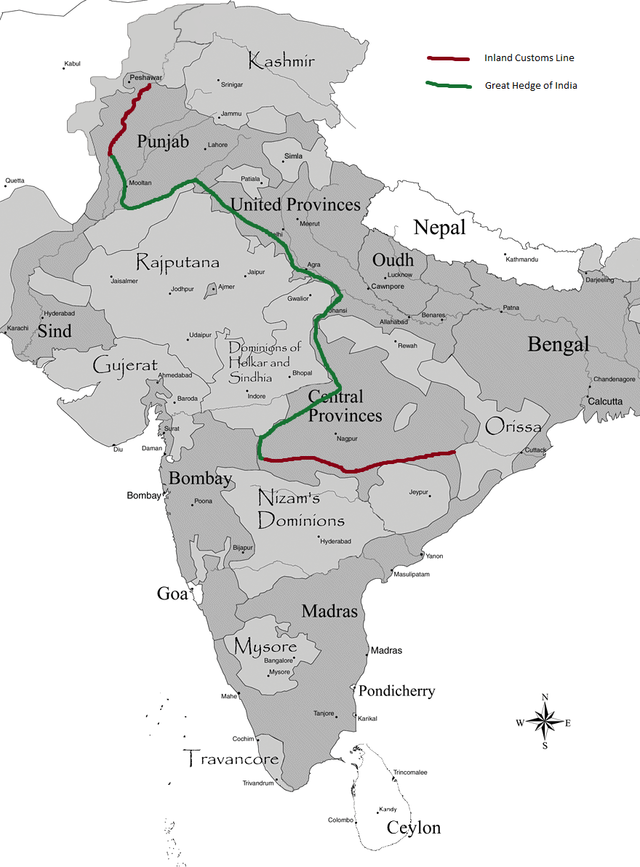
4000 kms from Punjab to Odisha with over 14,000 men guarding it at its peak in 1872. The Indians hated it, the British prided themselves on it, & Time cancelled it to a small embankment in Etawah (Uttar Pradesh).

Called The Great Hedge of India, part of the British Inland Customs Line, it is hardly known today, barring a few history enthusiasts. This living hedge made of local trees, shrubs & bamboo, divided the country & prevented free trade while exploiting Indians. The much-hated salt tax levied by the British in India, made salt a precious commodity, & bootlegging salt a highly-paid occupation.


Like a strong wall, the hedge was meant to prevent smugglers from illegally transporting salt. However, it ended up making transport & trade across the sub-continent cumbersome & expensive. Not to mention the staff needed to man the hedge, the constant fights with smuggling gangs, & the rampant corruption among the guards.
This mad project - to create a barrier across India using a dry hedge, began around the 1840s, when the British got a collective bee in their bonnets. The initial barrier was disconnected or scattered, as it was often destroyed by fire, insects or weather. In 1867, Alan Octavian Hume, the Commissioner of Inland Customs, decided to make the dry hedge into a living hedge that would reduce maintenance expenses, & then expand it across the country.

The hedge was transformed into a continuous line that was 4 to 14 feet wide in some stretches, with 8 to 12 foot-high trees & shrubs. Indigenous trees such as the Indian plum, babool, prickly pear, bamboo etc. made up this living hedge. After 1870, G.H.M Batten & thereafter W.S. Halsey continued Hume’s work, & fortified & expanded the Great Hedge to make it an ‘impregnable barrier’.

The British implemented their favourite ‘divide & rule’ policy when choosing the staff & employed a disproportionate number of Muslims who would police the mostly Hindu population. The Indian guards were often stationed far away from their native villages, & competed with the villagers for wood for the hedge. All this made the local population highly resentful of the Indian staff.
As strong as the Great Hedge was, it was not as effective in combatting smuggling, as the British had hoped. The harder they tried, the more creative the smugglers' ways to hoodwink the Customs guards. At one point, the cheeky ‘natives’ began burying salt & pretending to find the hidden goods, thus pocketing a neat 50% finder’s fee or reward!
The constant fights with smugglers, & corruption among the officers made the Hedge a drain on resources. In 1869, the Hedge cost £162,000 (in that time's money) to maintain. The number of smugglers convicted grew as the line expanded - from 2340 convictions in 1869 to 6037 in 1877 -78. The Hedge was also a public relations disaster, seen as a symbol of the unjust & merciless British Empire. The Great Hedge had become the Great Headache for the British administration.

The Great Hedge was finally abandoned in 1879 when the salt pans were taken over by the British & they could control the production & sale of salt. The much-detested salt tax was finally abolished in October 1946.
Today, the Great Hedge of India exists mostly in memory & a few old chronicles.
Read more about this fascinating part of our history!
'Great Hedge of India', by Roy Moxham https://g.co/kgs/S2QErs
Rambles & Recollections of an Indian Official, by Major General Sir Willliam H Sleeman, https://www.gutenberg.org/files/15483/15483-h/15483-h.htm#Ch60 Sir
News Article https://www.dnaindia.com/analysis/column-why-british-built-the-great-hedge-of-india-2648602
Article by Sarah Laskow for Atlas Obscura https://www.atlasobscura.com/articles/colonial-india-british-hedge-salt-tax
Wikipedia https://en.wikipedia.org/wiki/Inland_Customs_Line#Abandonment
Image Attributions
Map of India tracing the path of the Great Hedge By Derivative of British_india.png (by Kmusser), changes made by Dumelow.derivative work: Dumelow (talk) - British_india.png, CC BY 3.0, https://commons.wikimedia.org/w/index.php?curid=10582352
2. Rambles & Recollections of an Indian Official Book Cover https://www.gutenberg.org/files/15483/15483-h/15483-h.htm#Ch60
Portrait of Sir William H Sleeman By Unknown author - http://www.1902encyclopedia.com/T/THU/william-henry-sleeman.jpg, Public Domain, https://commons.wikimedia.org/w/index.php?curid=4855678
Except from Chapter 60, Rambles & Recollections of an Indian Official by William H Sleeman https://www.gutenberg.org/files/15483/15483-h/15483-h.htm#Ch60
Great Hedge of India , Illustration by Nigel Sussman, From Atlas Obscure https://www.atlasobscura.com/articles/colonial-india-british-hedge-salt-tax
Alan Octavian Hume, By Allan Octavian Hume - Nest and Eggs of Indian Birds, https://archive.org/details/TheNestsAndEggsOfIndianBirdsVolI, Public Domain, https://commons.wikimedia.org/w/index.php?curid=1631484
Great Hedge of India, Wallpaper Art by Gisele Amantea https://giseleamantea.ca/projects/the-great-hedge/
Trump Wall https://upload.wikimedia.org/wikipedia/commons/f/f2/U.S_-_Mexico_Border_Wall.jpg ; Amyyfory, CC BY-SA 4.0 <https://creativecommons.org/licenses/by-sa/4.0>, via Wikimedia Commons
#indianculture #greathedgeofindia #roymoxham #britishempire #colonialization #britishcolonialrule #britishcolonies #indianhistory #salttax #dandimarch #indlandcustomsline #britishcustoms #indiaheritage #freedomstruggle #indianindependence #indianroots #curiocity #indiastories #indiatales #degreekaapi #cultureshots #colonialrule #mexicanimmigrants #donaldtrump #trumpwall #immigrants #storiestogo #britishraj #officersoftheraj #williamsleeman #independenceday #republicday









.png)








Write a comment ...